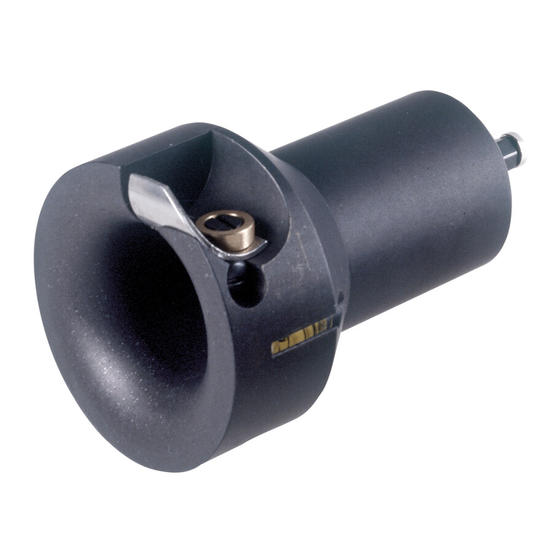
Table of Contents
Advertisement
Quick Links
Mini Tenon Cutters
Safety Rules
As with any power tool accessory, always wear eye protection.
These safety instructions are meant to complement those that came with your power tool. We
suggest that you reread those, in addition to those listed here before you begin to use this
product. To use this product safely, always follow both sets of safety and general instructions.
General Safety Rules
1. Read the manual. Learn the tool's applications and limitations as well as the specific
hazards related to the tool.
2. Use common sense. If an action appears to be unsafe, it likely is.
3. Wear proper eye/ear protection. Everyday eyeglasses have only impact-resistant lenses;
they are not safety glasses. Also use a face or dust mask if the cutting operation is dusty.
Visitors should wear the same protection.
4. Wear proper apparel. Avoid wearing clothing with loose sleeves. Do not wear gloves, ties,
rings or bracelets as these can get caught in moving machinery.
5. Long hair should be tied back and secured.
6. Do not work under the influence of drugs, alcohol, or medication. Drugs, alcohol,
medication and lack of sleep cause impaired judgment and coordination and should not be
combined with power tool operation.
7. Use in an appropriate environment. Power tools should be used only in dry, clean and well-lit
environments. Exposure to rain or use in the presence of flammable liquids or gases could
result in damage or injury.
8. Do not operate electric tools in gaseous or explosive environments. The spark of the motor
may cause the fumes to ignite.
9. Keep workplace clean. Cluttered areas and benches invite accidents.
10. Use correct power supply. Never use a power source for which this tool was not designed.
It could cause serious injury. If the tool is equipped with a three-prong plug, it should be
plugged into a three-hole electric receptacle. An adapter should be properly grounded.
11. Keep cord away from heat, oil and sharp edges.
12. Do not carry a plugged-in portable tool with finger on the switch.
13. Never carry portable tools by the cord.
14. Use the right tool. Do not force a small tool or attachment to do the job of a
heavy-duty tool.
15. Do not force tool. It will do the job better and safer at the rate for which it was designed.
16. Do not use damaged tools. A damaged tool that does not operate correctly is a safety hazard
and should be fixed before any further use.
17. Repairs and service should be performed by a certified technician. Use only identical
replacement parts.
18. Do not alter or misuse the tool. Stop any operation immediately if you notice
anything abnormal.
1
Advertisement
Table of Contents

Subscribe to Our Youtube Channel
Summary of Contents for VERITAS 05J41.01
- Page 1 Mini Tenon Cutters Safety Rules As with any power tool accessory, always wear eye protection. These safety instructions are meant to complement those that came with your power tool. We suggest that you reread those, in addition to those listed here before you begin to use this product.
- Page 2 19. Practice proper maintenance. Keep all tools sharp, clean and well lubricated for the best and safest results. Sharp blades minimize stalling, kickback, and burning. They perform faster, better and safer than dull blades. 20. Keep hands away from moving parts until they have come to a complete stop and the power has been disconnected.
- Page 3 ® The Veritas Mini Tenon Cutters cut 60° shouldered tenons on small stock. These small-diameter tenon cutters are ideal for chair rungs, decorative work on rustic furniture and wherever small tenons are required, e.g., trellis and lattice work, fan frames, etc. They require little torque while being driven by an electric drill.
- Page 4 Tip: If you do not have a vise, you can improvise with a piece of 2×4 with various sizes of V-shaped notches cut in it and two C-clamps. Place the piece of wood in a notch slightly smaller than its diameter, and clamp the 2×4 to a bench or a large stable surface. Place the tenon cutter on the end of the piece of wood and adjust the drill by eye so that it is in line with the piece of wood.
- Page 5 Adjusting the Shaving Thickness The blade can be adjusted to cut more aggressively Swivel about to produce larger shavings. Repeat the above front corner of blade. procedure, but swivel the blade away from the body shoulder, rotating it about the right-hand front corner, which is to remain in contact with the plug gauge.
- Page 6 Alternatively, you can sharpen the blade held at a 30° angle against a belt sander (fi tted with a 180x belt for rough sharpening, progressing to 15µ or fi ner for fi nishing). Do not hold the blade in contact with the belt for extended periods of time (more than few seconds) or you may overheat the blade.
- Page 7 05J41.03 Power Tenon Cutter, 1" 05J41.07 Power Tenon Cutter, 1 " 05J41.05 Power Tenon Cutter, 1 " 05J41.08 Power Tenon Cutter, 1 " 05J41.06 Power Tenon Cutter, 2" Veritas Tools Inc. Ottawa ON K2H 1C2 Canada veritastools.com © Veritas Tools Inc. 2018 341 INS-123_F...



Need help?
Do you have a question about the 05J41.01 and is the answer not in the manual?
Questions and answers